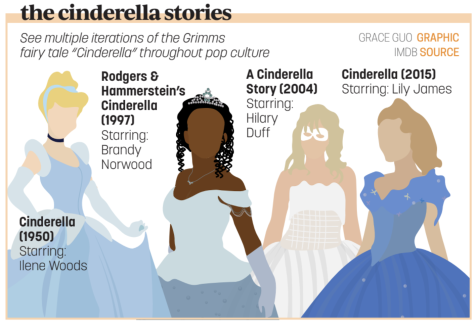Fairy Tales often incorporate magical and imaginary beings and lands, and they are often geared toward children. But fairytales can also help break boundaries of time and culture, and that includes how they portray people of color.
For Kristen Dawson, member of Black Student Alliance (BSA) and junior, fairytales give people a sense of freedom when talking about certain issues, especially in terms of how they portray people of color like her..
“(Fairy Tales) allow us to talk about dark and scary things through metaphors,” she said. These kinds of stories offer unexpected solutions to the oldest problems. They remind us that strangers can offer kindness when we are kind in return. They teach us that we do not need to be alone.”
Over the years, Disney has been criticized for its stereotypical portrayals of certain characters. Disney fairytales have been tracked for the type of people and genders that are featured in them and different themes that have emerged from their stories. It has been found out that Disney fairy tales have included an exercising power for men against women as well as a maintaining gender inequality trend.
James Ziegler, sponsor of BSA and social studies teacher, said the mission of BSA is to bring people together and discuss race related issues at the school or anywhere else they may come up in their lives. He also said members of BSA like to focus on community enrichment events such as attending racial equity meetings with our neighboring high schools, planning and being part of protests and celebrations of racial equality and playing games that center on Black culture. Ziegler said that fairy tales have definitely centered less around people of color in the past few years because of the rising stereotypes that people assume about them.
“Fairy tales help us understand that the values of once upon a time aren’t so different from our values now,” he said. They help us teach lessons and provide entertainment through understanding them; we can learn a lot from their meaning. These stories are older than even spoken words, but this does not lessen their importance. Since these stories are old they change over time and since many people are stereotyping people in today’s society the types of characters in these fairy tales are getting changed up just because how they look or what they act like which shouldn’t be allowed.
Along with Ziegler, Tomiwa “Vanessa” Rasaki, BSA leader and junior, said discussions about altering classic fairy tales doesn’t come without conflict.
“For the first time in about 20 years or so, there’s mere talk of black actresses playing one of the princesses (Zendaya as Ariel) and lots of people are against it. They say things like ‘Dark skin wouldn’t naturally occur under water, away from sunlight.’ There is no reason why a Black person shouldn’t be able to play the main character of a fairy tale, but there are still people out there that think differently,” Rasaki added.

Dawson, who said she has been reading and watching fairy tales since she was a kid, said the Alice in Wonderland story is one of her favorite fairy tales because of the message it portrays, but she also said the story could be better if people of color were incorporated in it because it would change the story fundamentally. She said those changes would help Black culture moving forward.
“I think that fairy tales influence our culture and storytelling significantly, and this is due to the fact that people read these stories as children which has an impact on how they grow up,” she said. I think the reason that these have such a big impact is due to the writers loading a great amount of symbolism that puts a sense of deep awareness on oneself. This symbolism has also impacted the way today’s character, plot and setting has led to today’s stories being even more exciting. Overall fairy tales have really had a huge significance on today’s culture and the way storytelling is told in today’s world
































![What happened to theater etiquette? [opinion]](https://hilite.org/wp-content/uploads/2025/04/Entertainment-Perspective-Cover-1200x471.jpg)














































![Review: “The Immortal Soul Salvage Yard:” A criminally underrated poetry collection [MUSE]](https://hilite.org/wp-content/uploads/2025/03/71cju6TvqmL._AC_UF10001000_QL80_.jpg)
![Review: "Dog Man" is Unapologetically Chaotic [MUSE]](https://hilite.org/wp-content/uploads/2025/03/dogman-1200x700.jpg)
![Review: "Ne Zha 2": The WeChat family reunion I didn’t know I needed [MUSE]](https://hilite.org/wp-content/uploads/2025/03/unnamed-4.png)
![Review in Print: Maripaz Villar brings a delightfully unique style to the world of WEBTOON [MUSE]](https://hilite.org/wp-content/uploads/2023/12/maripazcover-1200x960.jpg)
![Review: “The Sword of Kaigen” is a masterpiece [MUSE]](https://hilite.org/wp-content/uploads/2023/11/Screenshot-2023-11-26-201051.png)
![Review: Gateron Oil Kings, great linear switches, okay price [MUSE]](https://hilite.org/wp-content/uploads/2023/11/Screenshot-2023-11-26-200553.png)
![Review: “A Haunting in Venice” is a significant improvement from other Agatha Christie adaptations [MUSE]](https://hilite.org/wp-content/uploads/2023/11/e7ee2938a6d422669771bce6d8088521.jpg)
![Review: A Thanksgiving story from elementary school, still just as interesting [MUSE]](https://hilite.org/wp-content/uploads/2023/11/Screenshot-2023-11-26-195514-987x1200.png)
![Review: "When I Fly Towards You", cute, uplifting youth drama [MUSE]](https://hilite.org/wp-content/uploads/2023/09/When-I-Fly-Towards-You-Chinese-drama.png)
![Postcards from Muse: Hawaii Travel Diary [MUSE]](https://hilite.org/wp-content/uploads/2023/09/My-project-1-1200x1200.jpg)
![Review: "Ladybug & Cat Noir: The Movie," departure from original show [MUSE]](https://hilite.org/wp-content/uploads/2023/09/Ladybug__Cat_Noir_-_The_Movie_poster.jpg)
![Review in Print: "Hidden Love" is the cute, uplifting drama everyone needs [MUSE]](https://hilite.org/wp-content/uploads/2023/09/hiddenlovecover-e1693597208225-1030x1200.png)
![Review in Print: "Heartstopper" is the heartwarming queer romance we all need [MUSE]](https://hilite.org/wp-content/uploads/2023/08/museheartstoppercover-1200x654.png)



